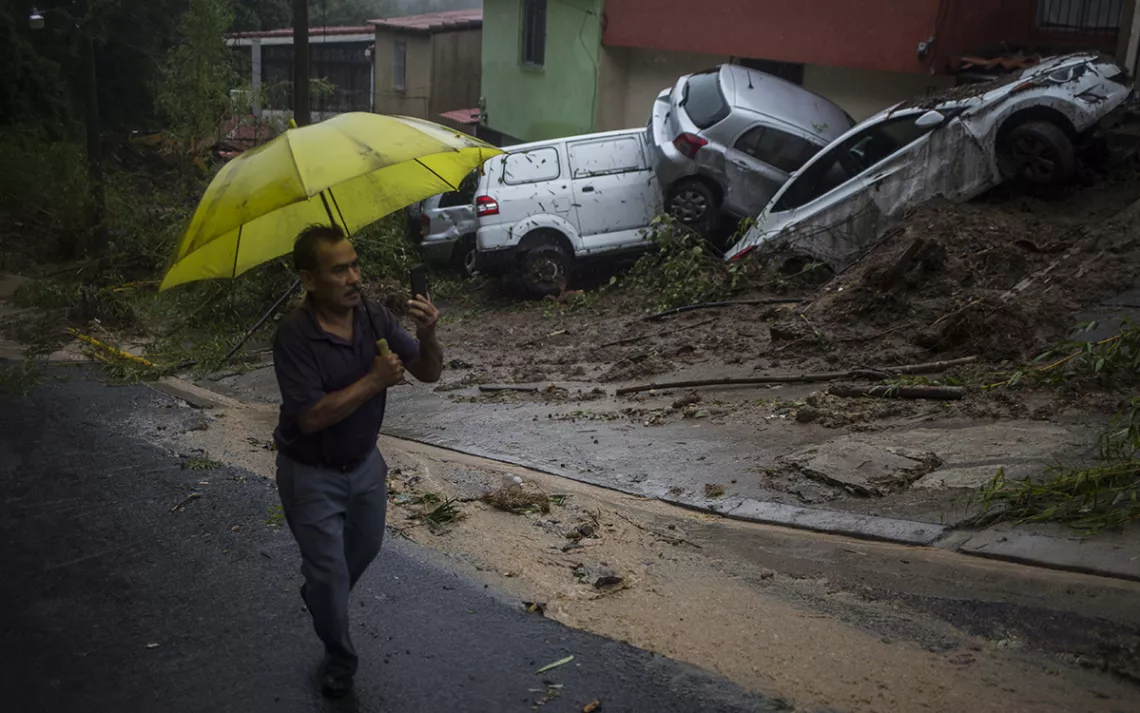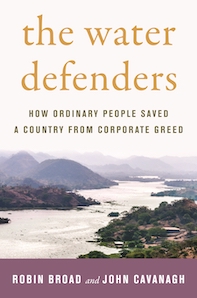El Salvador’s Water Defenders and the Fight Against Toxic Mining
A review of Robin Broad and John Cavanagh’s “The Water Defenders”

The aftermath of Tropical Storm Amanda, El Salvador, June 2020. | Photo by V'ctor Pe'a/picture-alliance/dpa/AP Images
 In 2017, El Salvador became the first country in the world to ban metal mining. Robin Broad and John Cavanagh present the story of the social struggles and legal battles behind that ban in The Water Defenders (Beacon Press, 2021).
In 2017, El Salvador became the first country in the world to ban metal mining. Robin Broad and John Cavanagh present the story of the social struggles and legal battles behind that ban in The Water Defenders (Beacon Press, 2021).
Broad and Cavanagh spent over a decade collaborating with the international solidarity movement supporting the Salvadorans’ fight against a proposed Pacific Rim gold mine. Their account is rife with valuable detail about the mobilizations, negotiations, alliance building, international campaigns, and legal maneuvers that stopped the Pacific Rim mining concession and led to the national ban.
The authors emphasize the importance of reaching out to government officials, church authorities, and long-standing political adversaries in building a broad and strong coalition. We learn that a right-wing environmental minister, Hugo Barrera, handed the water defenders an essential bit of legal strategy, and a conservative archbishop became an anti-mining activist upon hearing, in an initially tense meeting with the water defenders, that cyanide was being used to extract gold dust from the mountains.
“Unbeknown to the water defenders,” Broad and Cavanagh write, “there was more to Sáenz Lacalle than Opus Dei. The archbishop held a degree in chemistry. He knew well the toxic impact of cyanide. And with that knowledge, he did a 180-degree flip on mining.”
The authors also emphasize the absurdity of institutions like the World Bank’s International Centre for Settlement of Investment Disputes (ICSID). Much of the tension in The Water Defenders stems from the almost-seven-year-long Pac Rim lawsuit against El Salvador at the ICSID. Pac Rim sued the Salvadoran government for not issuing them a mining permit. It took the ICSID six years and 10 months—and cost the Salvadoran government nearly $13 million in legal fees and expenses—to rule against the mine. The ICSID based its ruling on the very legal issue that Barrera had pointed out during a National Action Week on Mining in 2006: The mine did not own the land, and the landowners did not want the mine.
And while both the authors and the water defenders met that legal decision with relief, if not celebration, Broad and Cavanagh wisely question the legitimacy of institutions like the ICSID and the rules they seek to enforce: “Why did a panel of three well-paid ICSID arbitrators—who … collectively made over $1.2 million in fees (excluding expenses) on the case—get to decide whether El Salvador’s mining law … was legal? Why should a panel of three de facto judges from other countries, using a biased set of rules, get to decide whether a sovereign nation’s laws were legal? We found this completely wrong, completely outrageous.”
Outrage is a frequently occurring sentiment in a story that begins with “white men in suits” drilling for gold. In the early 2000s, Pacific Rim Mining Corporation—acquired by OceanaGold in 2013—started drilling exploration wells in Cabañas Department, about 40 miles northeast of San Salvador. The authors describe Pac Rim “as one entity operating in its Canadian headquarters, as a Cayman Island shell company, and on the ground in El Salvador.”
At that time, there were no mines active in the region, and thus no opposition to mining. A local mayor from the right-wing ARENA party promoted landfills and industrial hog farms as “development” projects. Local opposition organized against him, stopping the landfill but not the 70,000 hogs.
Brothers Marcelo and Miguel Rivera, Broad and Cavanagh write, were key members of that opposition. They founded the first library and culture center in the town of San Isidro, in Cabañas, by going door-to-door to collect donated books. They built a few shelves in their family’s living room and called it the San Isidro Foundation for Culture and the Arts. Soon they had more books than space and secured permission to use a municipal building that had been abandoned since the Civil War, when it was used to store corpses.
The Rivera brothers and activists like Vidalina Morales and Antonio Pacheco of the local Association for Economic and Social Development (ADES) were quickly alarmed by the dried-up springs and groundwater sources caused by the mine’s exploratory drilling. They would become some of the earliest and most dedicated water defenders. They organized trips in 2004 and 2005 to visit mines in Honduras, where they saw the destroyed forests, dying rivers, skin diseases, and displaced communities caused by cyanide heap-leach mining firsthand. They returned more committed than ever to defend their forests, rivers, and communities.
Pac Rim was also quite committed to digging up the gold dust that lay beneath those forests, rivers, and communities. They began to throw money around to the mayor and host all manner of happy public events to promote the ideals of “development” that mining promised.
Broad and Cavanagh describe a few of these events, and the water defenders’ ingenious ways of subverting them. For example, Pac Rim bankrolled a local soccer tournament. Marcelo Rivera organized a team and raised the money to make uniforms that read “Out With Pac Rim” and “No to Mining.” They won the tournament.
In another case, Broad and Cavanagh write, “At one of their community meetings, a Pac Rim official boasted that cyanide was so safe that he was more than happy to drink a glass of a favorite local drink, horchata, laced with a white power he claimed was cyanide. The official, we are told by Miguel, backed down when community water defenders insisted on authenticating the cyanide sample before the liquid was drunk.”
Miguel Rivera then told the authors, “The company thought we’re just ignorant farmers with big hats who don’t know what we’re doing.”
Unfortunately, there is something of that same assumption lurking in The Water Defenders. The insistence on repeating the descriptor “ordinary people” in the subtitle and throughout the book strikes an odd note. These are people who risked, and some lost, their lives to defend their homes and communities and in so doing also achieved something unprecedented, something remarkable: a national ban on metals mining. What then does the term “ordinary” do here?
The answer lies, I think, in asides that Broad and Cavanagh make, such as this one, quoted in relation to the water defenders’ refutations of the miners’ claims about job creation: “The water defenders may not have had PhDs in economics, but they certainly had done their research.”
Perhaps Broad and Cavanagh just want to sound pithy, or wink at their academic and urban English-language readers, but the logic here is insidious: True knowledge must be certified, or in other words, legitimate knowledge must proceed from an academic discipline—economics—and an academic institution, the university, capable of granting a PhD. Notice how “research,” that is, the intellectual work that the water defenders did, is positioned as less than a “PhD in economics.” I fear that the term “ordinary people” does something similar: It positions rural people as somehow less than the urban and academically certified.
I do not think that Broad and Cavanagh do this on purpose—they write with admiration of the water defenders they met, befriended, and worked with—but this unacknowledged assumption haunts the book. The authors seem constantly surprised by the intelligence, creativity, and skills of the “ordinary people.”
For example, they write, “The popular wisdom on the environment is that it is the wealthier people in richer countries who care the most. The poor, it is often argued, cannot afford to worry about the environment. What then led Marcelo, Vidalina, and other ordinary, poorer farmers to become Water Defenders, to lead the charge to protect watersheds in El Salvador?”
I wonder for whom such “wisdom” is popular and who precisely makes such arguments? This sounds to me like the pro “development” reasoning of the very mining executives and World Bank arbiters the authors rightly criticize. And again, the insistence on describing the people fighting for their homes, for their land and water, and for their lives as “ordinary” and “poorer” farmers seems to reveal more about the class assumptions of the describers than the common attributes of the described.
Something else that haunts this book is the brutal 2009 abduction, torture, and murder of Marcelo Rivera. The first sentence of The Water Defenders reads, “In late June 2009, the two of us received deeply disturbing news: Marcelo Rivera had been disappeared.”
The authors write that they never met Marcelo Rivera and had first heard of him only a month before, in May 2009. That was when the National Roundtable on Mining in El Salvador was selected to win the Institute for Policy Studies (where Cavanagh works) Letelier-Moffitt Human Rights Award. They briefly describe Rivera’s disappearance and eventual discovery, murdered, at the bottom of a well.
“Though we never met Marcelo,” they write on the second page, “we have been haunted by him and the circumstances of his death ever since. Who killed Marcelo? And why?”
The authors go on to repeat this question at several points throughout the book. After describing the October 2009 award ceremony in Washington where Broad and Cavanagh first met a number of the water defenders in person, they write, “On that balmy evening in 2009, who could have guessed that Miguel’s questions [about the ICSID lawsuit] and Vidalina’s call to action would pull us two—and thousands of others around the world—into the vortex of three intertwined unknowns for nearly a decade to come?”
The first of these unknowns, they write, “was the on the ground mystery: Who killed Marcelo and why? Not just who carried out the brutal killing. Who was the mastermind?”
The second unknown was whether El Salvador could “possibly become the first nation on Earth to ban mining,” and the third was whether or not “little El Salvador [could] possibly prevail against the global mining industry in Washington, DC.”
While The Water Defenders addresses the second and third of these questions in great length—and is valuable for doing so—it offers only a cursory treatment of the first.
The timing and the context of Rivera’s murder make Pacific Rim an obvious suspect: The motive is there. Broad and Cavanagh write that San Isidro Mayor José Bautista also had political motives including but not limited to Rivera’s anti-mining organizing. The authors also tell us, unsurprisingly, that Salvadoran authorities never seriously investigated Rivera’s murder—nor the subsequent murders of other water defenders—but called it a “common gang crime” and arrested a few “gang members.”
We never learn, however, what those “gang members” said about Rivera’s murder and their arrest or whether or not anyone else tried to investigate. Initial investigative questions are never posed in the book: Were there any witnesses to his abduction? If not, who was the last person to see Rivera? Where was he? Did the government or anyone else carry out forensic analysis of the area around the well where his body was found? Did any independent investigators speak to the men charged in his murder?
While no family member, activist, or writer is responsible for investigating political murder—though often they are the only ones who do so—The Water Defenders fails to rigorously address the very question it uses as a narrative hook, and readers, too, are left haunted and wondering who killed Rivera and why.
 The Magazine of The Sierra Club
The Magazine of The Sierra Club



